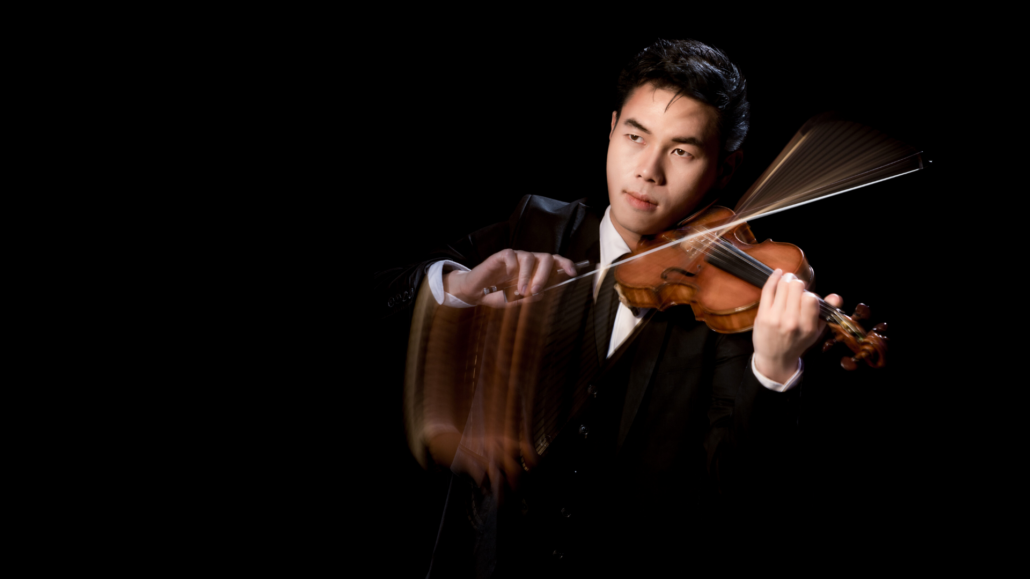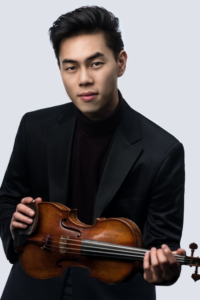KLUXEN & CHOOI – BARBER VIOLIN CONCERTO
November in Victoria can be cold and damp, but here we have a concert program that’s designed to raise the temperature of any attentive listener. At least that’s the opinion of Victoria Symphony’s former Composer/Mentor-in-residence Rodney Sharman, whose brief and elegant Scarlattiana will serve as the appetizer for a second course of Samuel Barber’s sole Violin Concerto, with Pyotr Ilyich Tchaikovsky’s monumental Symphony No. 5 in E minor as the pièce de résistance.
“In a sense,” Sharman explains, “the pieces move from a more Apollonian approach to a more Dionysian approach through the course of the program. There’s a kind of Classicism in my piece that becomes more Romantic in the Barber, and then of course very Romantic in Tchaikovsky.
“‘Cool to warm’ rings true to me,” he adds.
Sharman’s adaptation of Domenico Scarlatti’s Keyboard Sonata in F-sharp minor was commissioned and premiered by the Vancouver Symphony Orchestra. It is dedicated to Denise Ball (a CBC producer and longtime friend) and has since become the composer’s most-performed work. But what makes it especially appropriate for this Victoria Symphony program is that Sharman took his sonic cues from the great pianist Mikhail Pletnev, whose 1995 recording of 31 Scarlatti sonatas is one that VS music director Christian Kluxen knows intimately.
“I’m fascinated by Scarlatti’s language,” the conductor explains. “It is so modern, weird, and experimental for his time, to the point that it almost becomes mystical and esoteric. Its easygoing simplicity mixed with sudden unexpected dissonance and extreme virtuosity gives it a certain dramatic character, and when talking with Rodney about Scarlattiana, he seemed to have the same impression.
“But what was even more curious was that it was Mikhail Pletnev that opened his eyes to Scarlatti’s keyboard sonatas,” Kluxen continues. “My immediate response was ‘I know that recording! I have that as well!’ When I was studying Tchaikovsky’s Symphony No. 5 I found inspiration from every recording I could get my hands on, and one of the best was conducted by Pletnev, who peeled the score of any unnecessary layers and let the music speak for itself. I instantly became a fan of Pletnev and ended up buying his recording of the keyboard sonatas, which then opened my eyes to Scarlatti.”
Since its 1999 debut, one of the many honours that Scarlattiana has accrued came when choreographer James Kudelka used it to score a pas de deux between the National Ballet of Canada’s Rex Harrington and Xiao Nan Yu. This offers another connection between Sharman’s work and Tchaikovsky’s Symphony No. 5, which shares structural and thematic similarities with the Russian composer’s magnificent ballets, Swan Lake, The Sleeping Beauty, and The Nutcracker. The Barber Violin Concerto also contains balletic elements, but in the latter, it’s the soloist leading the dance—especially in what musicologist Elizabeth Ruth Flood has called the “suspenseful, sprightly, jovial, and furious” third movement.
“It’s definitely a showpiece,” says Victoria-born violinist Timothy Chooi, whose return to his hometown is keenly anticipated. Chooi points out that when the Violin Concerto was initially rejected by its intended dedicatee, Barber’s Curtis Institute of Music classmate Iso Briselli, for being too easy to play, the composer decided to tax the soloist’s abilities to the utmost. And he succeeded: Briselli switched gears and deemed the piece unperformable.
Obviously, that’s not an opinion Chooi shares. “Whenever you premiere a piece it is basically unplayable until you refine it,” he says, laughing. “And now, it is playable. It’s very difficult, but it’s playable.” Asked why he’s drawn to other formerly “unplayable” works such as Tchaikovsky’s Violin Concerto in D major and the Caprices of Niccolò Paganini, he has a simple explanation: “I’m young, and I still have these ligaments that work in my favour!”
Kluxen has no doubt that Chooi’s digits are up to the task. “Sometimes you just hear something in a soloist’s style, sound, or expression where you think ‘Wow, it would be great to hear this soloist play this or that,’” he notes. “Hearing Timothy’s playing, I immediately thought ‘Barber’! And for some reason, I feel that there is a strong connection between Barber and Tchaikovsky. It feels like both composers are truly virtuosic, but they almost choose to ignore their ability to easily create something. Instead, they search for the most difficult path to walk, in order to create something great, something profound. They constantly choose to doubt their creative abilities instead of just relying on them.
“The danger, of course, is that it becomes overdone, like a pasta dish with too many ingredients,” he adds. But with Pletnev’s clarity as an example, Kluxen’s own dancerly agility on the podium, and a soloist of Chooi’s strength, this concert should prove perfectly al dente, and utterly toothsome.
Notes by Alex Varty



 Christian Kluxen, conductor
Christian Kluxen, conductor